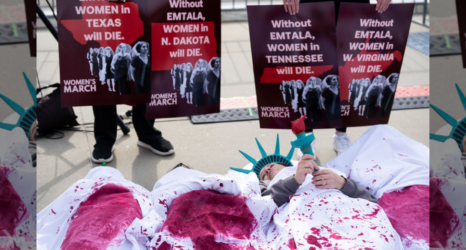Warning: This story contains details of severe abuse that may be triggering.
Updated Jan. 13 at 5:15 a.m. PT.
The story of a woman failed by every layer of our society—including, on the last night of her life, the United States Supreme Court.

This article is free to republish. Find additional guidelines at the end of this story.
Early Wednesday morning at the federal prison complex in Terre Haute, Ind., the U.S. government executed Lisa Montgomery after a flurry of legal efforts failed to outlast a Trump administration that was determined to put a lifelong victim of torture and severe mental illness to death.
She was the first woman to be executed by the federal government since 1953, and the 11th execution since the Trump administration reinstated the use of capital punishment after a 17-year suspension.
Lisa spent the last days of her life inside a prison suicide cell, hallucinating her abusive mother’s voice, suffering nightmares of the sexual torture she had endured, and drifting away “in a house in her mind,” just as she did while trying to survive being raped as a young teenager.
But as her attorney, Kelley Henry, said in a statement Wednesday morning, “Lisa was much more than the tragic crime she committed, a crime for which she felt deep remorse before she lost all touch with reality in the days before her execution. Lisa was also much more than the horrors inflicted upon her, the sexual violence and abuse she endured at the hands of those who were supposed to love, nurture and protect her.”
Before her death, Ms. published the following investigation of Lisa’s life, from a childhood of pain to motherhood behind bars—the story of a woman failed by every layer of our society, including, on the last night of her life, the United States Supreme Court.
“Don’t spank me, it hurts.”
Those were the first words of Lisa Montgomery at 18 months old. From the time she was a fetus growing in her mother’s womb until the day she was incarcerated for a gruesome crime committed in the throes of mental illness, Montgomery was relentlessly tortured by her mother, stepfather, husbands, strangers and other relatives.
Today, she spends what may be the last days of her life in solitary confinement, shivering in a thin gown in her frigid prison cell—the only woman currently on federal death row.
On December 16, 2004, Montgomery—who has since been diagnosed with borderline personality disorder, depression, post-traumatic stress disorder, brain damage, and dissociation, an altered state of consciousness that includes confusion and disengagement from reality—cut Bobbie Jo Stinnett’s baby out of her stomach and left the expectant mother to die. Montgomery pretended that the newborn was her own but within days was arrested and charged with kidnapping resulting in death. On April 4, 2008, a federal judge told her she’d be put to death.
Born to a family marked by mental illness, kidnappings, brain damage and domestic violence, Montgomery began her life in the womb with generations of trauma behind her, bathed in the alcohol that would contribute to impairment in part of her brain.
From a curious girl who used books as a safe harbor to a woman whose mental illness overcame her, Montgomery’s trauma compounded into tragedy.
Whether Montgomery lives or dies is now in the hands of a select few—including President Trump, as her lawyers appeal to him for a sentence of life in prison without parole, or at the very least, a delay of her execution until after the pandemic. Thus far, his administration has fought to have her executed in spite of the decades of abuse and trauma she suffered.
Entrapped by Abuse
Violence and neglect tormented Montgomery from the first months and years of her life.
Her mother and stepfather duct taped her mouth when she would speak out of turn, leaving Montgomery afraid to cry for fear she would suffocate. If young Lisa didn’t eat all of the food on her tray, her mother would leave her strapped in her high chair for hours. She and her younger sister Patty were beaten and held under cold water in the shower by their mother and stepfather.
“This woman had been a prisoner of war as a child,” Jan Vogelsang, a clinical social worker hired by Montgomery’s defense team to evaluate her, told Ms.
And it never stopped. Repeated incidents of torture by her mother and stepfather, among other family members, defined Montgomery’s childhood.
The summer after eighth grade, the rapes began.
“He’d wake me up and he just touch me on my body,” Lisa told a judge during her mother’s divorce proceedings in 1985. Lisa, then 17, admitted that she was terrified of her stepfather, Jack Kleiner. “He will hit us with his fist. … He made me have intercourse with him,” she said.
Her stepfather isolated her, building a small room onto the trailer where they lived so he could violate and torment her in private. “They could have screamed and the neighbors probably wouldn’t have heard them,” a witness said in a 2016 declaration to the court.
The criminal justice and social welfare systems appeared to fail Montgomery at every turn.
Her own mother, Judy Kleiner, testified to witnessing the rape, but didn’t call the police. She took her daughter to a doctor, who never reported the crime because he trusted her mother would do so. The divorce court judge called her mother’s failure to report the rape “inexcusable.”
Even a counselor let the abuse go unreported to the police when she found out that Jack broke a broom while beating Lisa.
“Whenever I told, no one did anything,” Montgomery said to Dr. Katherine Porterfield, a clinical psychologist hired by Montgomery’s lawyers who specializes in treating survivors of torture.
Montgomery’s own cousin, a law enforcement officer, took no action when he watched her cry and shake while confiding in him as a young teenager that her stepfather and a variety of other men were repeatedly gang raping her.

Lisa’s stepfather was never prosecuted.
“I live with regret for not speaking up about what happened to Lisa,” her cousin David Kidwell said in a declaration to the court in 2016. “I wonder if I had, if all of this could have been prevented.”
Lisa Montgomery’s Sister Protector
Only Lisa’s half-sister had tried to defend her.
Diane Mattingly fell in love with baby Lisa when she first saw her while she was playing on the floor in her grandmother’s living room. She knew then it would be her job to protect her, to feed her, to change her, to clothe her. The two girls were just four years apart, but Diane became Lisa’s caregiver, her shield against the torture.
At the age of six, when their younger sister Patty was born, Diane changed both girls’ diapers, cooked their meals and dressed them. She remembers hiding Lisa behind her in a corner and cradling their sister Patty on her hip as the young girls watched Montgomery’s mother, Judy, fight and shove an unknown man out the door of the house, trying to take cover from the violence.
Mattingly endured abuse, being thrown in a cold shower when she didn’t eat all her vegetables, left terrified for hours. Her stepmother Judy would strip Diane, shove her out onto the stoop, pack her clothes in a suitcase, and threaten to send her away.
At age eight, Judy finally did send Diane away, telling her it was her fault that a social worker had come to take her from the sisters she loved. As she drove away from the abusive home she was leaving behind, young Diane threw up repeatedly in the car. She knew she’d never be able to protect her sisters again.

Thirty-five years later, when she found out her half-sister—the baby she had cared for before being separated from her for decades—was sentenced to die, Mattingly was at work at the Kentucky Cabinet for Health and Family Services when she screamed out and collapsed.
“In my head, this is not gonna happen. They’re not gonna do this. They’re gonna realize this woman was tortured her whole life. Tortured,” Mattingly told Ms.
She expected life in prison, but never a death sentence.
Federal Executions Escalate
For the first time in American history, the federal government executed more people in 2020 than all of the states combined, according to a report by the Death Penalty Information Center, a nonpartisan, nonprofit organization that provides information and analysis on capital punishment. Montgomery would be the first woman to be executed by the U.S. government since 1953.
It was October, Domestic Violence Awareness Month, when Montgomery found out she would lose her life within months.
“If you want a symbol of how out of touch with the needs of domestic violence survivors this administration is, and how out of step with contemporary American values this execution is, I don’t think anything symbolizes it any better,” Robert Dunham, the executive director of the Death Penalty Information Center, told Ms.
Although more than a dozen other women have committed similar crimes, none of them were executed, research by the Cornell Center on the Death Penalty Worldwide shows.
Several mental health organizations, such as the American Psychological Association, have endorsed resolutions to end the death penalty for people with severe mental illness, and three major mental health groups have written a letter to President Trump protesting Montgomery’s execution.
“Our evolving standards of decency can no longer tolerate executing individuals with severe mental illness,” wrote the National Alliance on Mental Illness, Mental Health America, and the Treatment Advocacy Center.
While Trump’s Department of Justice has battled in court to see Montgomery put to death, the president has pardoned his political allies and cronies, including convicted criminals Roger Stone and Paul Manafort, as well as four Blackwater guards found guilty over the killing of more than a dozen Iraqi civilians.
Women, Misogyny and the Death Penalty in America
Between 1903 and 2015, 54 women were executed in the U.S., the vast majority by states rather than the federal government, according to data compiled by the Death Penalty Information Center and The Espy File. Women make up about 2 percent of death sentences between 1973 and September 2019, the DPIC reports.
Many of these women have something in common: They don’t fit society’s gender stereotypes, Mary Atwell, professor emeritus of criminal justice at Radford University and author of the book “Wretched Sisters: Examining Gender and Capital Punishment,” said. For example, many were painted by prosecutors as bad mothers, unfaithful wives or lesbians.
“The way they were portrayed in the eyes of the juries and in many cases in the eyes of the media was that they were failures as women and that was held against them in the judging of their behavior,” Atwell told Ms.
Montgomery was no different. Labeling her extensive history of trauma “the abuse excuse,” federal prosecutors during her trial said Montgomery kept a “filthy home” and didn’t cook, clean or attend her children’s events.
A forensic psychiatrist hired by the government testified that she was unfaithful to her first husband, Carl Boman—who was also her stepbrother. He claimed that Boman labeled Montgomery as manipulative and deceptive, often code words for women whose behavior contradicts society’s expectations.

In fact, what was framed as manipulative behavior was actually a sign of Montgomery’s severe mental illness and trauma.
Multiple mental health experts who have evaluated Montgomery diagnosed her with conditions such as complex post-traumatic stress disorder, borderline personality disorder, depression and brain damage resulting from head injuries sustained during abuse, her mother’s alcoholism during pregnancy, car accidents and dissociation.
“Psychiatric and neurologic disease affected every aspect of Lisa Montgomery’s life,” according to clinical social worker Vogelsang’s report analyzing Montgomery and her family’s personal history.
The extent and nature of Montgomery’s childhood abuse can contribute to the development of psychosis, according to a report by Dr. George Woods, a doctor specializing in neuropsychiatric consultations, who evaluated Montgomery on behalf of her defense team. In fact, Woods writes, several of the incidents of abuse Montgomery experienced qualify as torture under the United Nations Istanbul Protocol, written in 1999 to define how to properly investigate and document torture and its methods.
In just her first young years of life, Montgomery was subjected to whipping, slaps and punches, sexual abuse by her stepfather who pounded her head against a concrete floor, whipped her naked with a belt, and allowed other men to gang rape and urinate on her.
She was exposed to extreme cold temperatures and forced to witness and engage in violence against her sister by taking a board and hitting her until she bled.
These profound stressors of early life can cause brain dysfunction and a loss of contact with reality, including delusions, hallucinations, and mood disorders with symptoms of psychosis, Dr. Woods’s report says—all of which Montgomery endured.
And yet the gender-based violence Montgomery suffered is rarely considered a human rights violation in the eyes of the courts.
“Under international human rights law, it is the government that is responsible for protecting victims of gender-based violence. And the government failed that obligation here,” Sandra Babcock, one of Montgomery’s attorneys and the faculty director of the Cornell Center on the Death Penalty Worldwide, told Ms.
“Even before she came into contact with the criminal justice system, this is a woman whose human rights were violated by the government’s inaction,” Babcock added.
A 2018 report by the Cornell Center on the Death Penalty Worldwide’s Alice Project on women facing the death penalty around the world notes that international law prohibits the execution of individuals with mental illness or intellectual disability, but in practice, countries rarely abide by the recommendations of the United Nations. Most of the women put to death in the United States have been victims of physical, sexual or child abuse, the report states, citing Atwell’s research.
Lisa’s criminal trial in 2007 proved to be a continuation of the coercion and lack of agency she had experienced her whole life. An expert witness for the prosecution, Dr. Daniel Martell, testified that Montgomery may have been a “willing participant” in her own violent sexual torture as a young teenager. Another prosecution witness said he questioned whether Montgomery had consented to the brutal violations of her body.
When her most experienced attorney, Judy Clarke, was abruptly removed from her case without her knowledge or consent, Lisa wrote to the judge about her state of despair upon hearing she had lost a trusted ally.
“When I was asked what was wrong,” she wrote, “I replied that I had lost all hope.”
Lisa Montgomery: The Battle to Survive
To this day, Montgomery breaks out in hives if a man sits between her and a door, her attorney Kelley Henry told Ms., a side effect of lifelong rape, battery and coercion.
After enduring a lifetime of torture, much of it by men, Montgomery would be put to death in a men’s prison, a result of a male president and his male attorney general refusing to see her humanity.
Dr. Sara Boyd, a forensic psychologist not involved in Montgomery’s case, has seen the victimization of the most vulnerable in society too many times before. There must be consequences, she emphasizes, for these crimes, and the harm to Montgomery’s victim and her family is terrible and tragic.
But will killing Lisa heal their grief?
“What the outcome of that has been is not justice. It’s just been continued victimization of this other person who is looking at now a bunch of men deciding for the last time what’s gonna happen to her body. What they’re bound and determined to do is to victimize her one more time to make sure that her life ends on the same note that has been played over and over again the whole time like a drumbeat,” Boyd told Ms.
Reconnecting With a Child
Despite her failure to be a mother to her children, crippled by mental illness and the lessons of abuse by her own mother, in small ways, Lisa’s children remember her being present even for brief moments in time.
When Montgomery’s daughter Kayla Boman was four years old, the same age as Lisa when her beloved half-sister Diane was taken away from her, her mother knitted her a Looney Tunes blanket. “I treasure it,” Boman wrote to the court in 2013.
Montgomery has since crocheted baby blankets for Kayla’s children.
After Lisa’s conviction, Kayla didn’t speak to her for two years, but since then, the two have reconnected through pictures of Lisa’s grandchildren sent across prison bars. In 2012, Kayla went to visit her mom in prison. It was the first time Lisa had been emotionally present with her own child, Kayla told the court in a declaration.
“Mom realized right then what she had really missed out on with her kids, and what was lost between us all,” she wrote.
Life Behind Bars
Life as a free woman meant pain, victimization and the constant loss of the people and things Montgomery trusted for safety and escape: her half-sister Diane’s protection, the books on gardening and raising animals for a life of farming, and her enrollment in the Air Force after excelling in a summer program that was derailed by a family who forced her into a marriage at 18 that would mirror the violence of her youth.
Life in prison meant the medication she needed, and at times, a way to use her creativity to bond with her children, like the intricate dollhouse she made from inside prison walls: a doll dressed in purple on a white bedspread, a cheery pink pillow, a checkered tablecloth, family photos on the walls.
The three-story home is made of knit fabric. It was built on death row, a gift for children left behind by their mother’s absence.
“The house is the fulfillment of what she dreamed for herself and her children,” Vogelsang told Ms. in an email. “Creating it for them while waiting on death row was the closest she could come to that reality.”
This article is free to republish, under the following guidelines:
- Please credit Ms. as the original publisher. At the top of the text of your story, include a line that reads: “This story was originally published by Ms.” Link the word “This story” to this story, and the word “Ms.” to MsMagazine.com.
- You must credit the author of the article and include the bio below.
- You may also republish the photographs included in this story, including the original credit.
- If you share republished stories on social media, we’d appreciate being tagged in your posts. You can find Ms. on Twitter @MsMagazine, on Instagram @ms_magazine and on Facebook.
Our opponents are using the lame duck period—the time between now and when the new president is inaugurated, and a new Congress convenes—to do as much damage as they can. Help ensure Ms. remains strong and independent during this period of challenge and change. If you found this article helpful, please consider supporting our independent reporting and truth-telling for as little as $5 per month.





